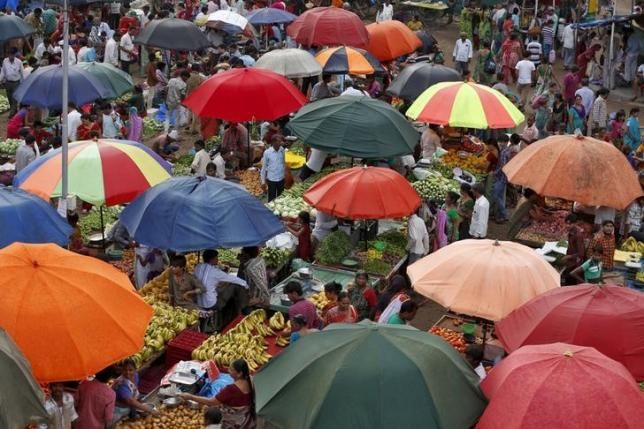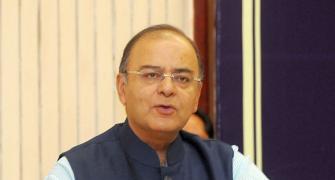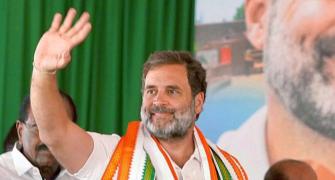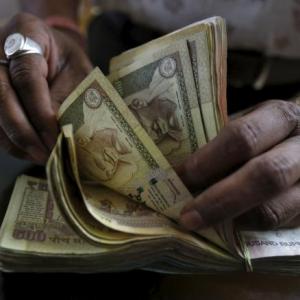Sources say as the finance ministry has pushed various departments to complete their allocated capital expenditure, spending has been frontloaded, in line with the finance minister's stated commitment of increasing public spending on infrastructure.
 In his attempts to meet this year's fiscal deficit target, Finance Minister Arun Jaitley has a number of factors working in his favour.
In his attempts to meet this year's fiscal deficit target, Finance Minister Arun Jaitley has a number of factors working in his favour.
This is despite the fact that the official economic growth estimate for this financial year is likely to be scaled down.
Contrary to what senior government policymakers have been saying, spending cuts are likely in FY16, too. Only these won't be as deep as in the past three years.
If the estimate for growth in gross domestic product (GDP) in FY16 is cut to 7.5 per cent (close to the Reserve Bank of India's estimate and the lower end of the range given by some officials in public), the finance ministry will see its spending space contract by Rs 30,000-35,000 crore or Rs 300-Rs 350 billion.
To meet the fiscal deficit target of 3.9 per cent of GDP, the ministry has to cut spending by this amount or carry it forward to the next financial year.
This amount is less than the corresponding figures of Rs 1.14 lakh crore for 2014-15, Rs 1.02 lakh crore or Rs 1.02 trillion for 2013-14 and Rs 79,653 crore or Rs 796.53 billion for 2012-13.
Earlier this week, Chief Economic Advisor Arvind Subramanian had said the official GDP growth forecast would be revised once data for the July-September quarter was available.
Given RBI's growth estimate of 7.4 per cent and the fact that forecasts by most rating agencies and multilateral organisations are below eight per cent, the official estimate will likely be scaled down from the Economic Survey estimate of 8-8.5 per cent.
"As Finance Secretary Ratan Watal said, the fiscal deficit target will be strictly maintained. However, if GDP estimates are revised downwards, there will have to be some spending cuts or roll-overs of certain spending items to stay within that target," said a senior government official.
Earlier this week, Watal had said expenditure cuts were unlikely this year.
Though officials the Business Standard spoke to declined to give the size of the cuts, here's what calculations based on already available information show: The FY16 Budget assumes real GDP growth of 8.5 per cent, and 11.5 per cent growth in nominal GDP.
Provided the deflator of three per cent remains constant, growth of 7.5 per cent could lead to a bump of 10.5 per cent, or nominal GDP of Rs 138.58 lakh crore or Rs 138.59 trillion for FY16, compared with the government's current estimate of Rs 141.08 lakh crore or Rs 141 trillion.
For Rs 138.58 lakh crore, the fiscal deficit target of 3.9 per cent works out to Rs 5.4 lakh crore, against the Budget estimate of Rs 5.56 lakh crore.
Revenue Secretary Hasmukh Adhia has said combined tax collections will stand at Rs 14 lakh crore or Rs 14 trillion, a shortfall of Rs 50,000 crore or Rs 500 billion compared to the Budget estimate. As such, net tax collections, excluding devolution to states, will also be hit.
These could stand at Rs 8.96 lakh crore or Rs 8.96 trillion, against the current expectation of Rs 9.2 lakh crore or Rs 9.2 trillion.
Adhia also said the non-tax revenue and non-tax capital receipts targets would be met.
If these are also constant, total receipts could be Rs 11.98 lakh crore or Rs 11.98 trillion.
If this is added to the fiscal deficit, it works out to Rs 17,37,986 crore or Rs 17.37 trillion.
Hence the spending gap between what the centre is planning to spend and what it will have to spend to stick to the fiscal deficit target is Rs 39,491 crore.
Add to that about Rs 25,000 crore or Rs 250 billion of expected additional spending on 'one rank, one pension' and on Pay Commission recommendations this financial year and take away Rs 30,000-35,000 crore or Rs 300-350 billion of major subsidy savings for this year, and amount that the budget makers may have to save is around Rs 30,000-35,000 crore.
That isn't likely to be difficult.
A part of the amount can be carried forward to the June quarter of 2016-17, especially the under-recovery payments to upstream companies.
Officials say crude oil prices of less than $70/barrel are expected next financial year, too, which will make it easier for the Centre to roll over some of the spending.
Second, sources say as the finance ministry has pushed various departments to complete their allocated capital expenditure, spending has been frontloaded, in line with the finance minister's stated commitment of increasing public spending on infrastructure.
For April-August, the overall capital expenditure, Plan and non-Plan, was Rs 92,000 crore or Rs 920 billion, the highest for the period since 1998-99, according to available data.
"This means even if some of the expenditure is pared in the second half of the financial year, we would still have fulfilled our commitment to spending more on infrastructure," said a second official.










